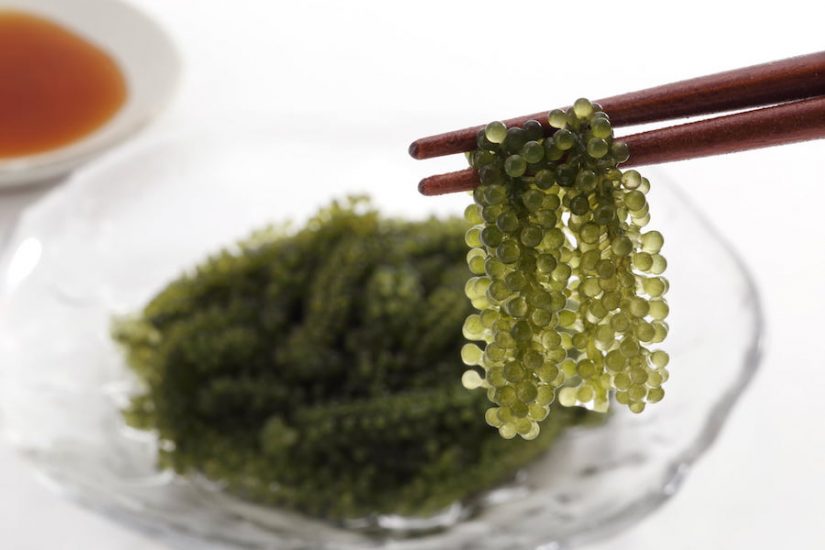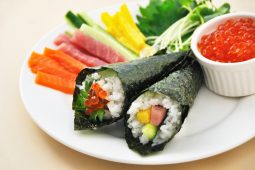The health benefits of eating seaweed regularly are now well known, but just as the English-speaking world is waking up to them, we are being told that the traditional diet and consumption of seaweed in Japan are “on the decline” as people turn to more “westernized” food.
Despite these claims, algae still make up a good percentage of the modern Japanese diet, particularly in the form of wakame (Undaria pinnatifida) in miso soup and salads, nori laver sheets (Porphyra umbilicalis) wrapped around sushi or rice balls or ao-nori (Ulva) sprinkled on okonomiyaki pancakes and tako-yaki doughballs, as well as kombu kelp (Saccharina japonica), which is used mainly to flavor stock, but also stewed until soft in soy sauce and mirin rice wine and served as a side dish with other vegetables or as a condiment for rice.
In addition, a brown alga called mozuku (Cladosiphon okamuranus), which is harvested in Okinawa, and the root of the wakame plant, known as mekabu, are readily available from supermarkets pre-cooked and/or marinated in vinegar. Moreover, another brown alga called hijiki is regularly served by Japanese households stewed with carrots or other vegetables, and kanten or agar is extracted from red algae for use as a thickener in desserts. Therefore, to my eyes, the consumption of seaweed is still very much a standard part of the Japanese diet and doesn’t show much sign of fading away — thank goodness!
Although seaweed is generally not a standard feature of the diet in Europe or America, in recent decades, the spread in popularity of Japanese cuisine around the world has been accompanied by a raised awareness of the nutritional effects of algae.
In English, however, the name “seaweed” conjures up negative images in the mind due to the word “weed”. Weeds are troublesome, inedible plants that get in the way of cultivating “good” plants for food. For this reason, the name seaweed tends to put English-speaking people off eating it, so marine food or health food companies often market it as “sea vegetables” or “algae” to avoid those negative connotations. Meanwhile, seaweed has been gaining in popularity in the west as a “super food” for quite some time, though it is still something of a “niche” market.
Also, companies selling seaweed in English-speaking countries often tend to use Japanese names for the different types and products due to the increased popularity of seaweed in the west being linked to Japanese cuisine. This is because the English names for many types of seaweed are not very well-known, therefore some companies even market non-Japanese seaweed types using Japanese names. The better-known English names for seaweeds around the shores of Great Britain and Ireland, such as dulse (Palmaria palmata), sloke (laver) (Porphyra umbilicalis) and carrageen (Chondrus crispus) actually originate in the Gaelic language because these types of seaweed grow in abundance in Gaelic-speaking coastal areas of Scotland and Ireland where the consumption of seaweed as food has a long history.
Nevertheless, one company based in Ireland markets its Irish seaweed products using Japanese seaweed names.Its dried badderlocks (Alaria esculenta) is sold as “Irish Wakame” and its dried purple, laver, usually known as “sloke” in Ireland, has been branded as “Irish Nori”. In addition, wakame and some other seaweed plants are harvested around the coast of France, and the resultant products also marketed under the Japanese names.
When I first arrived in Japan about 20 years’ ago, I didn’t know much about Japanese cuisine and was intrigued by the various types of seaweed I encountered at mealtimes, such as the green nori seaweed flakes (ulva/ao-nori) that were sprinkled as a garnish over okonomiyaki pancakes or tako-yaki dough balls and which added that now-famous umami flavor to the dish.
Since then, the years I’ve spent in Japan and eating Japanese cuisine means that seaweed is now a normal part of my own diet. There are two Okinawan seaweed dishes that I really like: sea grapes dipped in a flavorsome tsuyu fish stock and deep-fried mozuku tempura served with just salt. Another favorite at the moment is the condiment tsukudani, which many Japanese will have with their breakfast bowl of rice.It’s a kind of sweet nori spread made by simmering shredded nori in soy sauce, mirin and/or sugar down to a paste. In Wales, they eat boiled laver (Porphyra umbilicalis) which is similar in texture (though not in taste) to tsukudani as part of a Welsh fried breakfast. The pre-cooked laver, often sold in cans, is formed into a patty with rolled oats and fried in bacon fat alongside the eggs, tomatoes and bacon. As tsukudani nori spread can taste quite sweet, if you don’t like rice for breakfast, you could even try spreading it like jam on a slice of toast but go easy!








